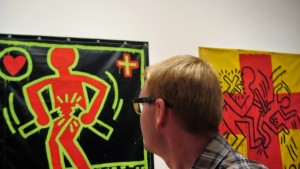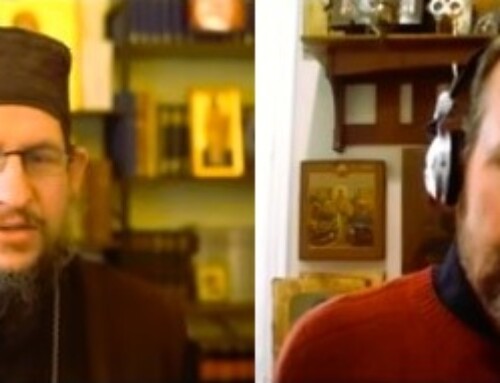
I recently attended the Keith Haring respective show in San Francisco. Besides the tragedy of his death at age 31 from AIDS, the entire exhibition was overlaid with an unavoidable air of sadness. Although his figures have no faces, therefore no facial expression, Haring’s line drawn characters are often crouching, cowering, and weeping. They reminded me of the therapeutic drawings done for psychologists by traumatically abused children. Yet, even more striking is his use of the most famous image he created: the crawling baby or “Radiant Baby” which Haring described as the “purest and most positive experience of human existence.” It’s the hurt little boy inside every gay man; the troubled and the reeling; constantly seeking out solace. For Haring, this was clearly his own self portrait. Oftentimes, the baby was being lifted a loft by a caring father, or cradled in a pair of huge loving manly arms. Inexplicably, in other works, I shocking saw the same figure being sodomized and copulated.
Haring said of his early days in New York City and in the gay lifestyle: “I was here at the peak of the sexual promiscuity in New York. I arrived, fresh from coming out of the closet, at the time and place where everyone was just wild. I was major into experimenting. If I didn’t get it, no one would. So I knew. It was just a matter of time.” When the inevitable happened, Haring was rather philosophical with regards to his own fate and to the AIDS crisis in general: “One thing that’s amazing is to watch people’s parents come to them. They haven’t been that close, maybe, because in a lot of cases homosexual men don’t have a particularly good relationship with their parents, especially their fathers. Maybe their fathers had totally rejected them. But then they came to them in the end and for the first time really opened up to them and showed them love.” Everywhere with Haring, you see this progression of complete immersion in perversity, eventual disease, and then restoration with the past through death. It’s an awful way to mend fences, by dying at 31.
Author’s note: I have a rather unorthodox interpretation of a famous Haring work: from 1982, the figure breaking a stick under the images of a heart and cross. Here Haring demonstrates his inability to conform homosexuality to the Christianity of his youth; homosexuality represented by the heart and Christianity by the cross; but, he is unable to do so and then dramatically smashes them apart once and for all. Again, it’s a sad piece, as you witness a man trying to make sense of himself and his homosexuality. He never really does; one of his last major works: the enormous pink cross – is megalithic; covered with muted figures covering their mouths. The Radiant Baby is still freaking out.






Very telling. My sons each have gay acquaintances (used to be friends) who are self-destructive and bitter. They can't seem to be happy as they are. Society tells us that WE are the problem. Our not embracing and celebrating the homosexual lifestyle is causing anguish and suicide, but it seems to me that it's the denial of what God has written on each of our hearts that is the true cause of the distress.
Just read an article on Alexander McQueen it talks about his life, suicide and amazing enough his early childhood. He was raped and abuse by a brother in law starting when he was 10 years old. You talk so much, especially in your book about self hate in gay men and then penance for violent behavior and Alexander was obviously in a lot of pain. https://www.dailymail.co.uk/news/article-2933678/Dark-fashion-fawned-fashion-world-awarded-CBE-new-biography-brilliant-designer-Alexander-McQueen-reveals-glamour-lay-man-prone-shocking-depravity-cruelty.html